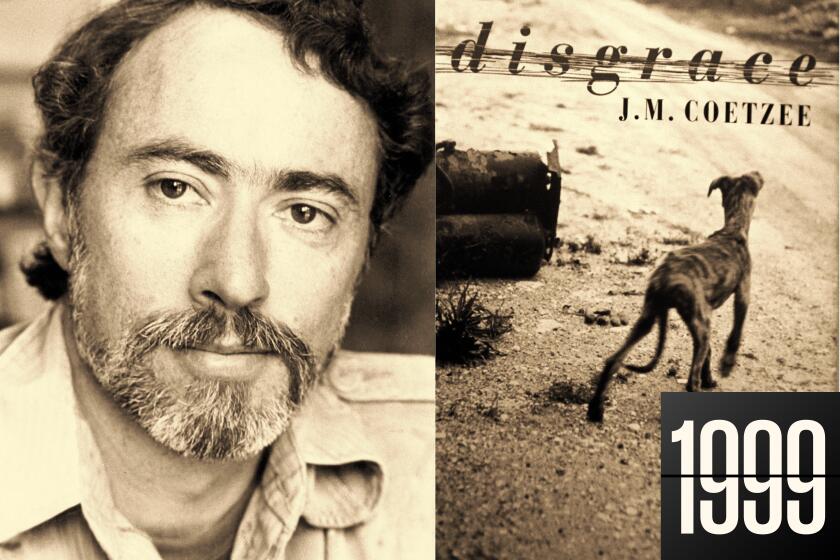Lucy’s ‘Real Life’ as a Really Bad Soap
The Real Life of Lucille Ball by Charles Higham (St. Martin’s Press; $17.95)
A cloying vulgarity and coarseness suffuse this book, but the author is either so cunning--or so closely allied in emotional terms with the subject of this biography--that the reader can’t tell if the vulgarity comes from Charles Higham or from Lucille Ball herself. One thing is sure: No matter how temperamental Ball was--no matter how she swore, or demanded perfection, or hounded poor Desi Arnaz, her first husband, or talked trash to the press about little Desi Jr.--no matter what she did, she shouldn’t have had to put up with a biography like this.
When trudging through the facts of her childhood, for instance, Higham takes us through the facts of Ball’s father’s death--when she was only 3: “In the second week, Henry’s temperature rose to 104 degrees. . . . He was miserably uncomfortable, restless and hot, his cheeks flushed and his pulse accelerated. His tongue was covered in whitish fur; sores appeared on his lips. His stomach was extended; he was stricken with diarrhea and discharges; rose-colored spots broke out all over him; there were bluish patches on the body and thighs. He was in a state of mental confusion and delirium. His body wasted, and his lips twisted and jerked; at last, he weakened fatally, stricken with toxemia and final debilitation. He died on Feb. 28, 1915.”
Traumatized by Quarantine
Just before this harrowing account, Higham suggests that being put under quarantine had a more than traumatic effect on little Lucille: “A notice was put on the door that read “Keep Out--Health Authorities.” This rejection and forced isolation . . . had a deep effect on Ball, contributing to her paranoid feelings of rejection later in life and perhaps inspiring a desire to make people accept and love her, a desire that consumes all entertainers.”
All this by page 17. The only trouble is, as in other popular biographies of the kind, there is no source given for any of this. Did Ball’s mother tell Mr. Higham? Did Ball herself? How could a 3 1/2-year-old remember all these harrowing details; how could a tot remember the bluish patches, the fur on the tongue. Couldn’t it be that Higham is exploiting his subject just the teeniest-tiniest bit?
At any rate, from then on Ball is referred to as “edgy” by her biographer, over and over again. She is also referred to here as having been an “extremely hyperactive child” who was “especially afraid of Gypsies.”
Suffering With Relish’
Again, where’s the source for this stuff? It reads dangerously like an old-fashioned movie magazine and gives the reader precious little real information about the young girl who would grow up to be a formidable American legend: “In her imaginary universe she was always either threatened by or subjected to terrifying mishaps, and in real life she was always twisting her ankle, tripping over foot stools or suffering from some childhood disease, often with theatrical relish. Chicken pox, measles, mumps and all the other children’s ailments for her assumed the proportion of the San Francisco earthquake.”
This probably was true for Ball, just as it is true for every other child in America, and perhaps the world.
But why be picky? By the time Ball gets to Hollywood, picks up parts in movies like “Follow the Fleet,” “Stage Door” and the zillion B movies that were to follow, you know that at least Higham has done his homework here.
Arnaz’s Turbulent Years
We follow the romance between Ball and Arnaz (although the alleged quotations of how they spoke to each other are so vulgar that they can’t be quoted in a family newspaper). We see a description of Arnaz as “ . . . A strict Roman Catholic, deeply locked into his family. . . . His father was a pioneer in dairy farming and delivering refrigerated milk. Desi grew up to be sturdy and athletic, fond of horses and fishing, bicycling and swimming. At a young age he was an enthusiastic visitor to the notorious Havana whorehouses, losing his virginity at 14. . . . During a Cuban revolution, his home in Santiago was burned to the ground; he managed to escape to the Mainland . . . where he worked in an importing company sorting tiles for roofs, and later feeding and caring for canaries.”
Poor Desi. Poor Lucy, locked into this particular biography. Higham glosses over the amazing parts of this story--the wondrous invention of “I Love Lucy,” America’s first real situation comedy. He takes another absolutely amazing adventure of the Ball-Arnaz duo--the naming of Ball as a Communist Party member by the powerful House Committee on Un-American Activities and the audacious and imaginative way the couple fought this charge--and treats the whole episode with considerably less verve and attention to specific details than he gave to Ball’s father’s typhoid fever.
Emphasis on Disasters
In fact, it’s the disasters that are emphasized in this narrative above everything else; for example, the pain of the divorce, particularly the pain of the Arnaz children. And the cruel, thoughtless and plain stupid remarks Ball made to the press about Desi Jr. when he was growing up.
The theme of this biography--which is written in extremely simple prose--is plain, and targeted to the lowest common denominator in the American public, those “unenlightened” masses who are assumed to be the largest television audience: “Money, enterprise and power . . . wrecked their personal happiness.”
Thus is the financial and artistic genius of Ball and her industrious and imaginative first husband denigrated. “She . . . will always be loved,” Higham finishes in a mealy-mouthed last sentence. But if she is, it will be due in no part to this biography.
More to Read
Sign up for our Book Club newsletter
Get the latest news, events and more from the Los Angeles Times Book Club, and help us get L.A. reading and talking.
You may occasionally receive promotional content from the Los Angeles Times.





